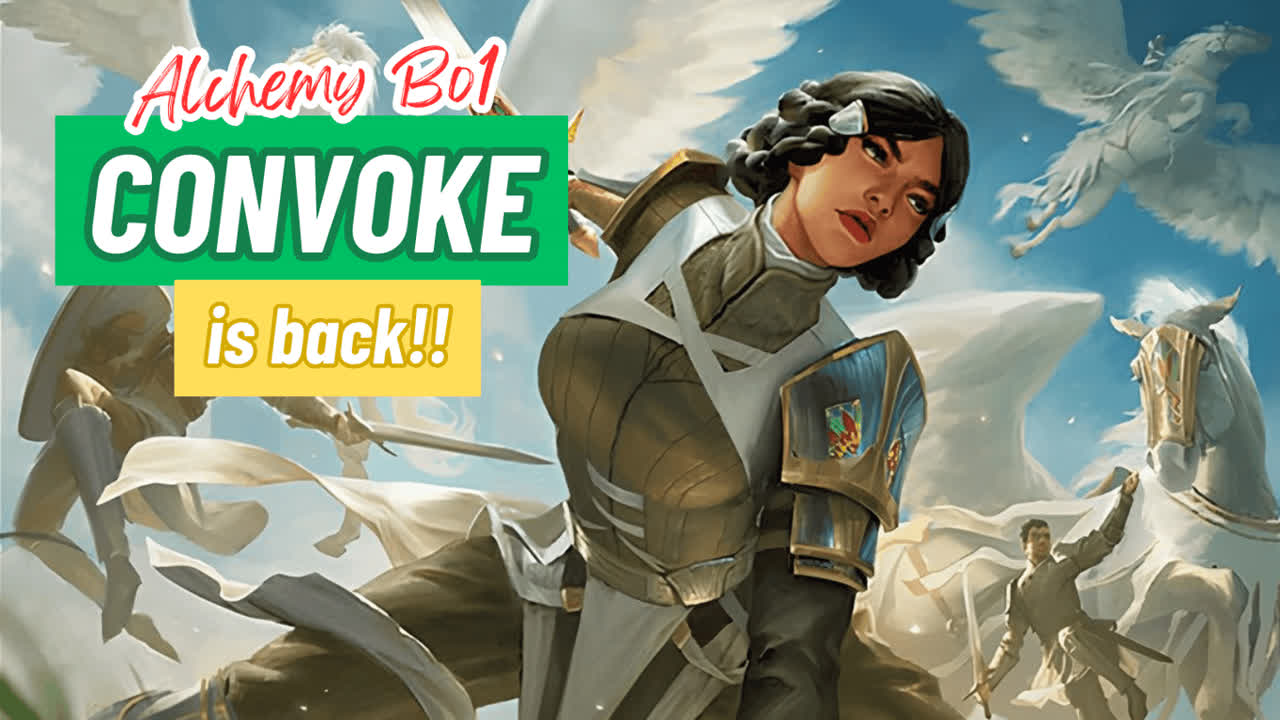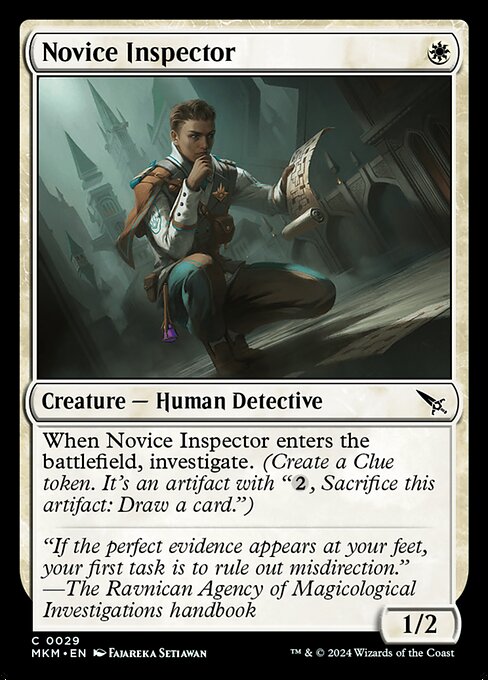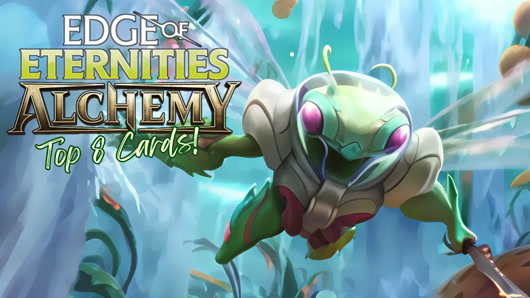Naya Convoke was definitely one of the most dominant decks in Alchemy Best-of-One last season, which ended not too many months ago with the arrival of Bloomburrow!
This date, in fact, marked the rotation of the format the beginning of a new metagame, where Convoke could no longer be present, having lost too many important cards to remain competitive.
Aside from some potentially replaceable 1-drops, the biggest losses were definitely Resolute Reinforcements and Knight-Errant of Eos, along with most of the untapped lands: BRO's painlands and ONE's fastlands, which made the mana base solid and aggressive, despite the Naya tricolor.
Convoke was dead and destined to be a thing of the past, but as the format evolved and it was forgotten, it quietly began to regain some cards!
Bloomburrow brought Pawpatch Recruit, which is a great 1-drop. Alchemy: Bloomburrow brought Buxton, Decorated Host, which immediately seemed like a decent alternative to Knight-Errant of Eos. Duskmourn instead brought verge lands, although unfortunately not in its full cycle, but which are still acceptable untapped duals. But the definitive turning point has come right now with the arrival of Foundations, which, in addition to the excellent Llanowar Elves, brought us the reprint of Resolute Reinforcements!
I guess for many this still wasn't enough since no one saw it coming, but, ladies and gentlemen, here we are... Convoke is back!
Selesnya Convoke
Starters
Let's kick things off with the “starters,” which are the creatures we usually want to play first.
Novice Inspector is already well known as it is played in Convoke of all formats and it creates a Clue that will become a card as soon as we have two free mana, and which here is further enhanced by Llanowar Elves and Ruby Collector's Mox Ruby.
Precisely because it provides value right on the way in, the opponent will be reluctant to spend a removal spell on it, and it’s therefore ideal for making tempo plays on the opponent's open mana and if we want our pieces to survive to convoke quickly.
In the opposite case, however, there is Llanowar Elves, who accelerates and will often call for removal on itself.
It allows you to get busted starts, getting Emmara, Voice of the Conclave, and up to five creatures as early as turn 2. As well as allowing you to ramp Sanguine Evangelist or Pawpatch Recruit with offspring, significantly contributing to its versatility as a 1-drop and 3-drop.
It also synergizes with Buxton, Decorated Host, during a stalemate, where creatures can't attack and thus tap. Llanowar Elves can instead tap for mana, causing Rabbit Noble to trigger at the end of the turn and adding an additional 1-drop to the team!
Speaking of Buxton, Decorated Host's trigger, I'll tell you in advance that one of the exclusions from my list is Warden of the Inner Sky, even though it would have been useful for tapping creatures with its ability. It was particularly useful in the old Convoke list for the mirror match, which is no longer there for obvious reasons, and in the meantime the meta has evolved by greatly increasing removal spells, so that most of the time it's no longer worth losing aggression and making tempo loss to pump it.
Cenote Scout is instead a cross between Novice Inspector and Llanowar Elves, because it can call removal on itself, becoming a 2/2 and making scry 1, or providing value on the way in, drawing a land.
It’s excellent in the early game to ensure all the lands we need, but it’s not too bad even in the late game controlling the draw.
Go-Wide
Pawpatch Recruit is another 1-drop that we might sometimes want to do on turn 1 to be more aggressive, but that we will often consider doing at 3 mana to extract the maximum value from it.
In addition to being versatile, it also guarantees a decent resistance to enemy removals, buffing a team member, and aiding the aggro plan.
It's no coincidence that Pawpatch Recruit, Llanowar Elves, and Cenote Scout are green and make up the majority of 1-drops, and that's because they want the white Resolute Reinforcements as a follow-up. By doing so, it's possible to cast Emmara, Voice of the Conclave already on turn 2, without having to use too many cards, but immediately putting many creatures and pressure on the board, so as to leave the opponent behind.
Resolute Reinforcements is the glue of the deck, putting two pieces into play for just two mana at instant speed, proving to be great for both the go-wide aggro plan and for convoking quickly.
Just as at least two pieces are put in by Sanguine Evangelist, which costs 3 mana, but which are mitigated by Llanowar Elves.
It's great that it creates an additional 1/1 Bat when it dies, so you can easily trade it in combat when you don't want to take an aggressive route, or at least leave us with something on the board after mass removal.
Go-Wide Payoffs
Ok, we have a lot of creatures, but how to make the most of them? We have two ways: by buffing them en masse and by using them for convoke!
Ruby Collector is another 1-drop, but, when you have the choice, it should be played last, maybe just before attacking with three creatures so that it triggers immediately.
The fact that it boosts the team multiple times by paying 1R is the reason to still keep a small red splash with Inspiring Vantage and Captivating Crossroads, but even if these are not available, no problem, because Ruby Collector itself will provide it to us by conjuring Mox Ruby!
Case of the Gateway Express is the deck's only removal spell and is especially important for removing dangerous enemy early drops that can otherwise snowball the game, such as Golden Sidekick, Manifold Mouse, Emporium Thopterist, or Thieving Aven.
By attacking with at least 3 creatures, it resolves and gives +1/+0 to everyone, often also useful for not overexposing yourself or restarting post-wrath.
Sanguine Evangelist, which we previously appreciated for its skill to create tokens, is also excellent at strengthening the team thanks to battle cry, and for this and other reasons I preferred it to another great missing from this list: Imodane's Recruiter. In short:
- Llanowar Elves makes better use of Sanguine Evangelist as a 3-drop;
- Red mana isn't consistent enough to be able to cast Imodane's Recruiter at any time;
- It's just a 2/2 if sought with Buxton, Decorated Host;
- There is no Knight-Errant of Eos to take it when you need it to close the game.
Convoke Payoffs
Emmara, Voice of the Conclave is most likely the strongest creature in the deck, as it can be cast with zero or little mana and immediately goes 2-for-1, choosing one of three random cards from her spellbook!
The latter consists of 9 spells with convoke, which we can divide into:
- Good: Ancient Imperiosaur, March of the Multitudes, Knight-Errant of Eos;
- Medium: Conclave Tribunal, Venerated Loxodon;
- Bad: Loxodon Restorer, Triplicate Spirits, Overwhelm;
- Unplayable: Nissa's Expedition.
Obviously we will tend to give priority to those of the first two groups, even if everything will depend on the randomness of the three spells that will come to us, on the need, and on the state of development of our board.
Although not exciting, in the right spot, even a weak spell can do its job, just as Loxodon Restorer can help against Burn, and Triplicate Spirits can hit in the air when there are too many creatures on the ground.
Then there is Buxton, Decorated Host, who filled the void left by Knight-Errant of Eos and who has pros and cons if we compare them. It is certainly better at making a board, since at the end of each turn it seeks a piece directly into play, unlike Human Knight, which triggers only on entry, adding two creatures to your hand.
This meant that Knight-Errant of Eos, once resolved, was nothing more than a 4/4 that could perhaps be handled, while Buxton, Decorated Host, despite having already triggered once, is a 4/4 that still needs to be removed because it continues to trigger at the end of each of our turns.
However, among its cons is the fact that it cannot select creatures, but above all, it adds all its value on the battlefield, making our game plan particularly vulnerable to mass removals.
Tips & Tricks
Finally, here are 10 tips and information that I haven't yet provided in the card descriptions.
- When casting a convoke spell, be sure to click Llanowar Elves to specify that you want to tap it for convoke and not for mana. Otherwise, MTG Arena will default to mana, which is relevant if the spell in question is Ancient Imperiosaur or Knight-Errant of Eos.
- In the few cases where it will be indifferent and you can afford it, pay Buxton, Decorated Host by tapping the lands and not the creatures, if they aren't already 5. By leaving no more than 4 creatures tapped at the end of the turn, you will prevent the Rabbit from tutoring a copy of itself.
- Buxton, Decorated Host seeks a permanent, not just a creature. That means it can also find Case of the Gateway Express as removal, but be aware that it won't resolve that turn, even if you attacked with 3 or more creatures.
- Soldier tokens from March of the Multitudes have lifelink, which will allow you to gain life even when casting Case of the Gateway Express, which allows all of your creatures to deal damage.
- In case of an overcommitted board with too many creatures, you can solve it by putting as many tokens as possible with March of the Multitudes, then pumping them several times with Ruby Collector and battle cry.
- If you already have both Selesnya colors, consider naming red with Captivating Crossroads, in case you draw Ruby Collector.
- If you have Hushwood Verge and Forest as your only lands, along with a bunch of white creatures, lead with Verge even if apparently it doesn't matter. You could draw Plains and unlock double white to cast double spells.
- Ancient Imperiosaur is the most explosive pick and often the best; the one that makes you win the fastest, especially if your opponents don't play black (it's less likely to be removed by white or blue spells).
- Although Overwhelm is among the worst spells, sometimes you might pick it anyway with the late game in mind if the other choices are still disappointing. Even if it's overcosted, with a lot of mana and a stalled board, it can still solve the game.
- Unlike the old Naya Convoke that had Knight-Errant of Eos to not run out of cards in hand and Imodane's Recruiter to win from nowhere, Selesnya extends more on the board and therefore suffers more from mass removal. Often it takes more than one to defeat you, but always carefully evaluate whether you can play around it or not.
That's all for today! As you have seen, I think the time is ripe for Convoke to return to the competitive scene, but since I know you're already wondering, will it still be that dominant? Well, the power level of the format seems to have increased a lot lately, and even worse, decks now have all the tools they need to counter a go-wide strategy like this, starting with mass removals that are now available for every mana cost, such as Pyroclasm, Slagstorm, Split Up, Day of Judgment and Deadly Cover-Up.
The deck is still super fast though and certainly capable of punishing any opponents who haven't seen it coming, as well as being absorbed into the metagame and being just another brick in the wall of competitive Alchemy!

















